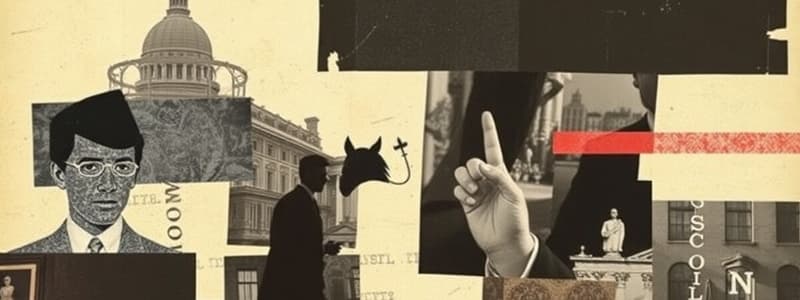Podcast
Questions and Answers
What is crime?
What is crime?
A specific act of commission or omission in violation of the law for which a punishment is prescribed.
Is killing someone inherently criminal according to Sykes and Mazza's neutralization theory?
Is killing someone inherently criminal according to Sykes and Mazza's neutralization theory?
False (B)
What does 'dynamic concept of crime' mean?
What does 'dynamic concept of crime' mean?
- Criminal acts are always visible.
- All crimes are inherently evil.
- Crime can change based on laws and social perceptions. (correct)
- Once a crime, always a crime.
What historical law made alcohol consumption illegal?
What historical law made alcohol consumption illegal?
Which of the following is an example of a malum in se crime?
Which of the following is an example of a malum in se crime?
How many states have legalized marijuana for recreational use as of 2024?
How many states have legalized marijuana for recreational use as of 2024?
The DEA currently considers marijuana a schedule one drug.
The DEA currently considers marijuana a schedule one drug.
Match the following classifications of crime with their characteristics:
Match the following classifications of crime with their characteristics:
Which of the following is NOT considered a visible crime?
Which of the following is NOT considered a visible crime?
What does UCR stand for?
What does UCR stand for?
What is the primary focus of the National Crime Victimization Survey?
What is the primary focus of the National Crime Victimization Survey?
The UCR primarily reports crime incidents that were reported to the police.
The UCR primarily reports crime incidents that were reported to the police.
Between which years did the UCR indicate that reported crime was going down?
Between which years did the UCR indicate that reported crime was going down?
What phenomenon describes the difference between crimes reported to police and those experienced by victims?
What phenomenon describes the difference between crimes reported to police and those experienced by victims?
In which year did a notable increase in concern about crime among the public begin to rise?
In which year did a notable increase in concern about crime among the public begin to rise?
Homicides in Chicago occur in approximately 50% of the city's census tracks.
Homicides in Chicago occur in approximately 50% of the city's census tracks.
What major event in 2001 significantly impacted public perception of crime?
What major event in 2001 significantly impacted public perception of crime?
According to public perception, how much crime was thought to occur annually as of 2022?
According to public perception, how much crime was thought to occur annually as of 2022?
What percentage of Chicago's census tracks do not experience homicides?
What percentage of Chicago's census tracks do not experience homicides?
Flashcards are hidden until you start studying
Study Notes
Crime Data and Perceptions
- Two sources of crime statistics: Uniform Crime Reporting (UCR) and National Crime Victimization Survey (NCVS)
- UCR focuses on reported crimes, while NCVS focuses on self-reported victimization
- Both data sources have limitations:
- Not all crimes are reported
- Memory recall can be inaccurate
- While there are differences in the magnitude of crime reported between the two sources (NCVS reports almost twice as much crime as UCR), both sources generally show similar trends
- Crime rates in the US have been on a downward trend since the 1990s, according to both UCR and NCVS data
- Public perception of crime often differs from actual crime trends
- Despite crime rates declining, a majority of Americans believe crime is increasing
- Public perception may be influenced by media coverage and sensationalized news stories
- Crime is highly concentrated in specific geographic areas
- While the media may report crime in some areas, residents may not experience it directly, leading to distorted perceptions
- Political ideology has also influenced crime perceptions
- Since 2001, there has been a growing divergence in crime perceptions between different political groups
- Crime perceptions are often inaccurate and influenced by media, news, and selective information
- Crime is a complex phenomenon with patterns, but people often fail to consider context and focus on negative information
The Prison Business
- A woman shared a shocking anecdote about a Wall Street client who built prisons
- This client allegedly determined the number of prison cells needed based on the failure rates of Black boys in the fourth and fifth grades
- While initially dismissed as a conspiracy, the speaker was later proved wrong
- This anecdote suggests a disturbing reality about the prison industry, where the suffering of certain populations is profited from
Studying That Suits You
Use AI to generate personalized quizzes and flashcards to suit your learning preferences.



